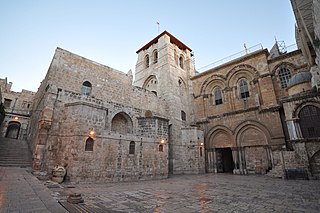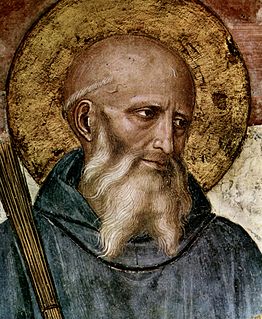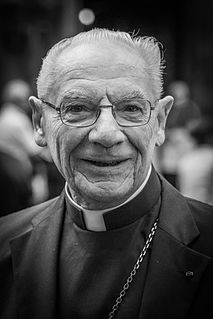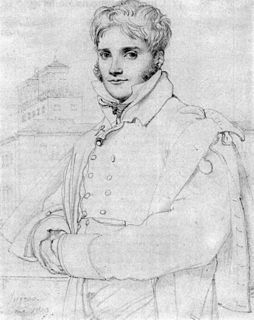
Christianity is an Abrahamic monotheistic religion based on the life and teachings of Jesus of Nazareth. It is the world's largest religion with roughly 2.8 billion followers representing one-third of the global population. Its adherents, known as Christians, are estimated to make up a majority of the population in 157 countries and territories, and believe that Jesus is the Son of God, whose coming as the messiah was prophesied in the Hebrew Bible and chronicled in the New Testament.

Year 529 (DXXIX) was a common year starting on Monday of the Julian calendar. At the time, it was known as the Year of the Consulship of Decius without colleague. The denomination 529 for this year has been used since the early medieval period, when the Anno Domini calendar era became the prevalent method in Europe for naming years.

Pope Felix IV was the bishop of Rome from 12 July 526 to his death. He was the chosen candidate of Ostrogoth King Theodoric the Great, who had imprisoned Felix's predecessor, John I.

The East–West Schism is the break of communion since 1054 between the Roman Catholic and Eastern Orthodox churches. Immediately following the beginning of the schism, it is estimated that Eastern Christianity comprised a slim majority of Christians worldwide, with the majority of remaining Christians being Western. The schism was the culmination of theological and political differences which had developed during the preceding centuries between Eastern and Western Christianity.

Modernism in the Catholic Church attempts to reconcile Catholicism with modern culture, specifically an understanding of the Bible and Catholic tradition in light of the historical-critical method and new philosophical and political developments of the late 19th and early 20th centuries.
Semi-Pelagianism is a Christian theological and soteriological school of thought on salvation. Semipelagian thought stands in contrast to the earlier Pelagian teaching about salvation, Pelagianism which had been dismissed as heresy. Semipelagianism in its original form was developed as a compromise between Pelagianism and the teaching of Church Fathers such as Saint Augustine, who taught that people cannot come to God without the grace of God. In semipelagian thought, a distinction is made between the beginning of faith and the increase of faith. Semipelagian thought teaches that the latter half – growing in faith – is the work of God, while the beginning of faith is an act of free will, with grace supervening only later. It, too, was labeled heresy by the Western Church at the Second Council of Orange in 529.

Caesarius of Arles, sometimes called "of Chalon" from his birthplace Chalon-sur-Saône, was the foremost ecclesiastic of his generation in Merovingian Gaul. Caesarius is considered to be of the last generation of church leaders of Gaul who worked to promote large-scale ascetic elements into the Western Christian tradition. William E. Klingshirn's study of Caesarius depicts Caesarius as having the reputation of a "popular preacher of great fervour and enduring influence". Among those who exercised the greatest influence on Caesarius were Augustine of Hippo, Julianus Pomerius, and John Cassian.

John Cassian, also known as John the Ascetic and John Cassian the Roman, was a Christian monk and theologian celebrated in both the Western and Eastern churches for his mystical writings. Cassian is noted for his role in bringing the ideas and practices of early Christian monasticism to the medieval West.

Paul Joseph Jean Poupard is a French prelate of the Catholic Church who has been a Cardinal since 1985. He held positions in the Roman Curia for more than 25 years, serving as President of the Pontifical Council for Culture from 1988 to 2007 and briefly as President of the Pontifical Council for Interreligious Dialogue.

Henri-Marie Joseph Sonier de Lubac, better known as Henri de Lubac, was a French Jesuit priest and cardinal who is considered one of the most influential theologians of the 20th century. His writings and doctrinal research played a key role in shaping the Second Vatican Council.

Salomon de Brosse was an early 17th-century French architect who moved away from late Mannerism to reassert the French classical style and was a major influence on François Mansart.

Signature Books is an American press specializing in subjects related to Utah, Mormonism, and Western Americana. The company was founded in 1980 by George D. Smith and Scott Kenney and is based in Salt Lake City, Utah. It is majority owned by the Smith-Pettit Foundation.

Maurice Blondel was a French philosopher, whose most influential works, notably L'Action, aimed at establishing the correct relationship between autonomous philosophical reasoning and Christian belief.

The Loyal Orange Institution, commonly known as the Orange Order, is an international Protestant fraternal order based in Northern Ireland and primarily associated with Ulster Protestants, particularly those of Ulster Scots heritage. It also has lodges in England, Scotland and the Republic of Ireland, as well as in parts of the Commonwealth of Nations, Togo and the United States. The Orange Order was founded by Ulster Protestants in County Armagh in 1795, during a period of Protestant–Catholic sectarian conflict, as a fraternity sworn to maintain the Protestant Ascendancy in Ireland. It is headed by the Grand Orange Lodge of Ireland, established in 1798. Its name is a tribute to the Dutch-born Protestant king William of Orange, who defeated Catholic king James II in the Williamite–Jacobite War (1688–1691). The order is best known for its yearly marches, the biggest of which are held on or around 12 July, a public holiday in Northern Ireland.

The ancient residential diocese of Orange in the Comtat Venaissin in Provence, a fief belonging to the Papacy, was suppressed by the French government during the French Revolution. It was revived in 2009 as a titular see of the Roman Catholic Church.

Merry-Joseph Blondel was a French history painter of the Neoclassical school. He was a winner of the prestigious Prix de Rome in 1803. After the salon of 1824, he was bestowed with the rank of Knight in the order of the Legion d'Honneur by Charles X of France and offered a professorship at the École nationale supérieure des Beaux-Arts: a position in which he remained until his death in 1853. In 1832, he was elected to a seat at the Académie des Beaux-Arts in Paris.

There are 72 Grade II* listed buildings in the city of Brighton and Hove, England. The city, on the English Channel coast approximately 52 miles (84 km) south of London, was formed as a unitary authority in 1997 by the merger of the neighbouring towns of Brighton and Hove. Queen Elizabeth II granted city status in 2000.
The Second Council of Orange was held in 529 at Orange, which was then part of the Ostrogothic Kingdom. It affirmed much of the theology of Augustine of Hippo, and made numerous proclamations against what later would come to be known as semi-Pelagian doctrine.














